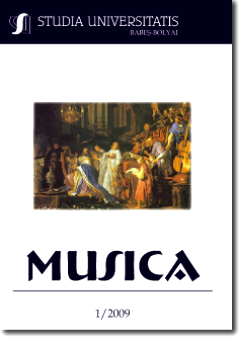THE HERZLICH TUT MICH VERLANGEN CHORALE WITHIN DIFFERENT ORGAN ARRANGEMENTS IN BUXTEHUDE AND BACH’S WORKS
Keywords:
arrangement, chorale preludes, Herzlich tut mich verlangen, Ach Herr mich armen Sünder, protestant choraleAbstract
The primary role of the organ from the standpoint of the Protestant Church and its liturgy is to accompany the church choir as well as the congregation. During the entrance and exit of the congregation, the precentor can choose to perform any musical material or even more, to improvise the piece. Organists of the 17th and 18th century were masters of congregational singing, being also outstanding improvisers. The very best organ masters worked within the German Lutheran (or Evangelical) Church, for they allowed instrumental music to be played, the chorale being an excellent “raw material” for future variations. I have chosen the Herzlich tut mich verlangen chorale as my theme, along with some of other arrangements for organ, such as the chorale prelude Ach herr, mich armen Sünder, BuxWV 178 composed by Dietrich Buxtehude (1637-1707), along with Herzlich tut mich verlangen, BWV 727 and Ach herr, mich armen Sünder, BWV 742 by J.S.Bach (1685-1750).
References
***, Larousse, Dicţionar de mari muzicieni, (Dictionary of Great Musicians) Ed. Univers Encilopedic, 2000.
***, The New Grove Dictionary of Music and Musicians, vol. V., Oxford University Press, Oxford, 2001.
Bach, J.S., Orgelchorale der Neumester-Sammlung, Bärenreiter Urtext, Orgelverke Band 9, 2005
Bach, J.S., Orgelwerke, Urtext, Band V, C.F.Peters, Frankfurt.
Buxtehude, Dietrich, Sämtlische Orgelwerke, Breitkopf & Hartel, Wiesbaden, 1986.
Gáncs, Aladár, Az ötödik evangélista. (The fifth Evangelist), Ed. Budapesta, 1985.
Geiringer, Johann Sebastian Bach, Budapesta, 1976
Gruber, R.I., Istoria muzicii universale (Universal music history), Editura muzicală, vol. I., II., 1961.
Győrffy, István, Összhangzattani kalauz a Bach-korálokhoz (Harmonic guide for Bach’s chorales), Ed.Tárogató, Budapesta, 1994.
Kelemen, Imre, A zene története 1750-ig (Music History until 1750),Tankönyvkiadó, Budapesta, 1991.
Keller, Hermann, Die Orgelwerke Bachs, Edition Peters, Leipzig.
Kovács, László Attila, Zenélő, éneklő egyház (Musical, singing church), Cluj, 2003.
Kulp, Buchner - Farmaçon, Siegfried, Die Lieder unseres Kirche, Arno Buchner und Siegfried Farmaçon, Gottingen, 1958
Michels, Ulrich, SH Atlasz Zene (Musical Dictionary), Spinger Hungarica, Budapest, 1994.
Schweitzer, Albert, J.S. Bach, VEB Breitkopf Hartel Music verlag, Leipzig, 1954.
Türk, Erich Michael, Introducere în construcţia orgii şi exemple de scriitura idiomatică din perioada 1600-1930, (Introduction in organ construction as well as examples of idiomatic writing from the period between 1600-1930), Academia de Muzică "Gheorghe Dima" din Cluj- Napoca, 1997.
Williams, Peter, The Organ Music of J.S. Bach, III. A Background, Cambridge University Press, Cambridge, 1986.
Wolff, Christoph, Johann Sebastian Bach a tudós zeneszerző (J.S. Bach, the scientist composer); Ed. Park, Budapesta, 2004.
Downloads
Published
How to Cite
Issue
Section
License
Copyright (c) 2009 Studia Universitatis Babeș-Bolyai Musica

This work is licensed under a Creative Commons Attribution-NonCommercial-NoDerivatives 4.0 International License.



